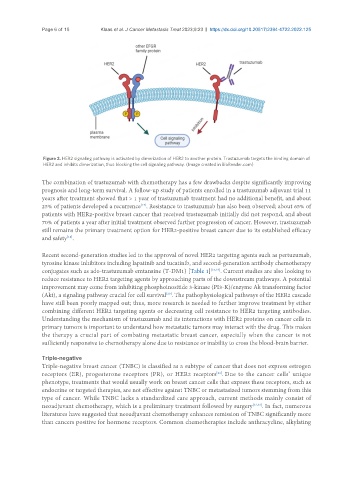Page 432 - Read Online
P. 432
Page 6 of 15 Klaas et al. J Cancer Metastasis Treat 2023;9:23 https://dx.doi.org/10.20517/2394-4722.2022.125
Figure 2. HER2 signaling pathway is activated by dimerization of HER2 to another protein. Trastuzumab targets the binding domain of
HER2 and inhibits dimerization, thus blocking the cell signaling pathway. (Image created in BioRender.com)
The combination of trastuzumab with chemotherapy has a few drawbacks despite significantly improving
prognosis and long-term survival. A follow-up study of patients enrolled in a trastuzumab adjuvant trial 11
years after treatment showed that > 1 year of trastuzumab treatment had no additional benefit, and about
[17]
25% of patients developed a recurrence . Resistance to trastuzumab has also been observed; about 65% of
patients with HER2-positive breast cancer that received trastuzumab initially did not respond, and about
70% of patients a year after initial treatment observed further progression of cancer. However, trastuzumab
still remains the primary treatment option for HER2-positive breast cancer due to its established efficacy
and safety .
[18]
Recent second-generation studies led to the approval of novel HER2 targeting agents such as pertuzumab,
tyrosine kinase inhibitors including lapatinib and tucatinib, and second-generation antibody chemotherapy
conjugates such as ado-trastuzumab emtansine (T-DM1) [Table 1] [15,19] . Current studies are also looking to
reduce resistance to HER2 targeting agents by approaching parts of the downstream pathways. A potential
improvement may come from inhibiting phosphoinositide 3-kinase (PI3-K)/enzyme Ak transforming factor
(Akt), a signaling pathway crucial for cell survival . The pathophysiological pathways of the HER2 cascade
[20]
have still been poorly mapped out; thus, more research is needed to further improve treatment by either
combining different HER2 targeting agents or decreasing cell resistance to HER2 targeting antibodies.
Understanding the mechanism of trastuzumab and its interactions with HER2 proteins on cancer cells in
primary tumors is important to understand how metastatic tumors may interact with the drug. This makes
the therapy a crucial part of combating metastatic breast cancer, especially when the cancer is not
sufficiently responsive to chemotherapy alone due to resistance or inability to cross the blood-brain barrier.
Triple-negative
Triple-negative breast cancer (TNBC) is classified as a subtype of cancer that does not express estrogen
[21]
receptors (ER), progesterone receptors (PR), or HER2 receptors . Due to the cancer cells’ unique
phenotype, treatments that would usually work on breast cancer cells that express these receptors, such as
endocrine or targeted therapies, are not effective against TNBC or metastasized tumors stemming from this
type of cancer. While TNBC lacks a standardized care approach, current methods mainly consist of
neoadjuvant chemotherapy, which is a preliminary treatment followed by surgery [22,23] . In fact, numerous
literatures have suggested that neoadjuvant chemotherapy enhances remission of TNBC significantly more
than cancers positive for hormone receptors. Common chemotherapies include anthracycline, alkylating

